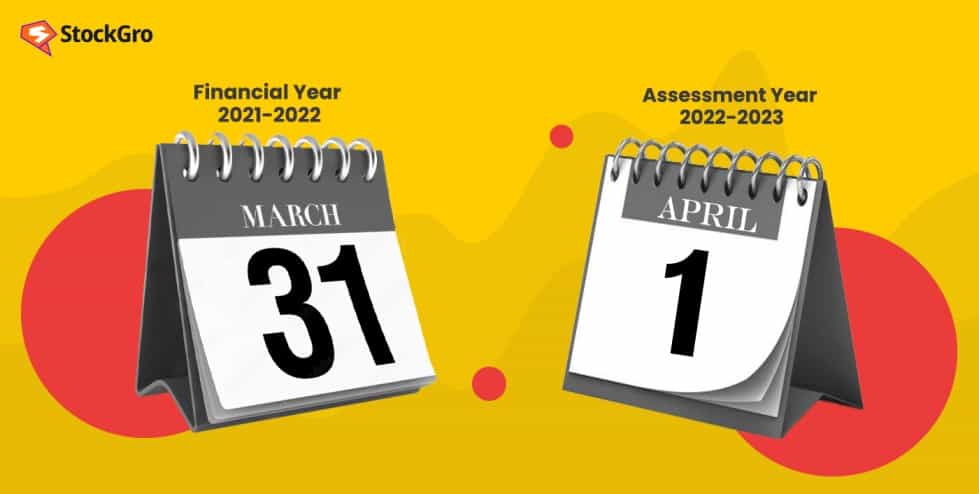
In the intricate world of taxes and finances, the calendar does not follow the conventional January-to-December pattern. Instead, it dances to its tune, led by assessment year and financial year. These two-time frames help us understand how your earnings align with your tax responsibilities.
While the two terms are often used interchangeably, it is essential to understand the differences between them as they play a significant role in tax computation, accounting and other areas of financial planning.
Let’s begin your journey through this financial time capsule to decode the relationship between the financial year and the assessment year.
You may also like: The concept of EPF – All you need to know about this tax-saving fund
Financial year
Financial year means the calendar year when you earn money. It is the period from April to March when you count your income, expenses, and taxes. It begins from April to March of the next year. During this time, you track your earnings and plan your taxes.
Understanding this year is crucial for managing your finances well, helping us make smart money decisions and stay on top of your financial goals. It is like your financial compass for the year ahead.
Assessment year
Now, the assessment year comes right after the financial year ends. It is like a review period. During this year, you look at your financial activities from the previous year. You report how much money you earned and spent, especially for tax purposes.
So, while the financial year is all about making and spending money, the assessment year is about whether you have paid the correct taxes based on what you did in the financial year. It is like a financial check-up to ensure everything is in order with the tax authorities.
Also read: What are financial securities? Examples, types, and importance
Relationship between financial year and assessment year
The financial year and assessment year are interconnected terms in the world of income tax. The financial year (FY) is the period in which you earn income, while the assessment year (AY) is when you declare and assess that income for tax purposes.
For example, if you earn money from April 2022 to March 2023, that is the FY, and the AY for that income is 2023-24.
You file a return for income tax for the assessment year. So, the tax return you filed in AY 2023-24 pertains to the income you earned during FY 2022-23. It is like reviewing and reporting all financial transactions for the past year.
How are financial transactions linked between the two?
The financial year sets the stage for the assessment year. All your financial transactions, income, expenses, and taxes paid during the financial year come under scrutiny and assessment in the subsequent assessment year. This assessment determines your tax liability for the money earned during the financial year.
The financial year is when you earn, and the assessment year is when you reckon and report it to the tax authorities.
Also read: EBITDA explained: Definition, calculation, significance, and more
Assessment year vs. financial year
| Factors of differentiation | Financial year | Assessment year |
| Definition | It is a period of 12 months within which you earn your income and make financial transactions. | This begins once the financial year ends and is when you file your tax return based on the previous financial year’s income. |
| Earning & Reporting | You earn income, pay taxes, and conduct financial activities within this year. | It is solely for reporting and assessing the income that was received in the previous financial year. |
| Tax Calculation | No direct tax calculation happens in this period. | This is when you calculate and pay taxes based on your financial year’s income. |
| Important Dates | It runs from April 1st to March 31st. | It begins on April 1st and ends on March 31st of the following year. |
| Filing Returns | You do not file tax returns during this time. | You file tax returns for the previous financial year during this period. |
Compliance and deadlines
In simple terms, the assessment year is like the period when you look back at your financial year and tally up your taxes. For India, this assessment year starts on April 1st and ends on March 31st of the following year. It is the period when you gather all your financial documents, crunch numbers and file your tax return. Think of it as settling your financial scorecard.
Not sticking to the assessment year’s deadlines or dodging your financial duties can come with consequences. Think of it as a late fee for not paying your electricity bill on time. It is always wiser to follow the rules, meet the deadlines, and keep your financial journey smooth and hassle-free.
Bottomline
Understanding the link between the AY and FY is very important for every taxpayer. It is like two steps in a synchronised routine, and if you miss a beat, you could stumble. So, keep your financial records in tune, meet those filing deadlines, and you will glide through tax seasons with confidence.
Stay compliant, stay informed, and let your financial journey be a harmonious one.

